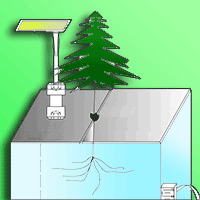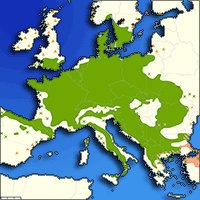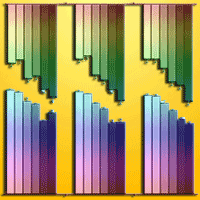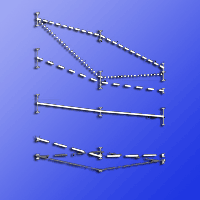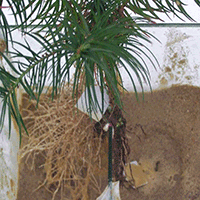
Nutrient uptake, allocation and biochemical changes in two Chinese fir cuttings under heterogeneous phosphorus supply
Taimoor Hassan Farooq (1), Mulualem Tigabu (2), Xiangqing Ma (1), Xianhua Zou (1), Aiqin Liu (1), Per Christer Odén (2), Pengfei Wu (1)
iForest - Biogeosciences and Forestry, Volume 11, Issue 3, Pages 411-417 (2018)
doi: https://doi.org/10.3832/ifor2657-011
Published: Jun 05, 2018 - Copyright © 2018 SISEF
Research Articles
Abstract
Plant-available nutrients in soils are usually distributed in a heterogeneous or patchy manner. Plant responses to low levels of phosphorous (P) are not uniform across and within species. In this study, we examined the adaptive role of physiological plasticity (increased rate of nutrient uptake in localized zones) to the heterogeneous distribution of P in the soil, and whether low P stress transcends to the shoot and triggers similar biochemical changes that enhance tolerance. Two Chinese fir clones with high P efficiency (M1, which is tolerant to low P, and M4 which is able to decouple fixed P) were chosen as the research materials and their physiological responses to low P stress were examined using a sand culture experiment. For both clones, there was no significant difference in nutrient concentration between P-replete and P-deficient patches. Heterogeneous P supply did not affect the allocation of nutrients to the above-ground parts of the plants. The activity of acid phosphatase (APase) and malondialdehyde (MDA) content increased initially but declined with increasing duration of stress, while the content of soluble protein and total chlorophyll contents remained unaffected by the heterogeneous P supply. We conclude that physiological plasticity plays no role in adaptation to low P stress in these clones, while the changes in APase activity and MDA content in needles suggest functional metabolic processes are involved in enhancing P-efficiency in these clones.
Keywords
Chinese Fir, Physiological Plasticity, Low Phosphorus Stress, Acid Phosphatase Activity, Nutrient Accumulation
Authors’ Info
Authors’ address
Xiangqing Ma
Xianhua Zou
Aiqin Liu
Pengfei Wu
College of Forestry, Fujian Agriculture and Forestry University, Fuzhou, 350002 Fujian Province (PR China)
Per Christer Odén
Southern Swedish Forest Research Center, Faculty of Forest Science, Swedish University of Agricultural Sciences, PO Box 49, SE-230 53 Alnarp (Sweden)
Corresponding author
Paper Info
Citation
Farooq TH, Tigabu M, Ma X, Zou X, Liu A, Odén PC, Wu P (2018). Nutrient uptake, allocation and biochemical changes in two Chinese fir cuttings under heterogeneous phosphorus supply. iForest 11: 411-417. - doi: 10.3832/ifor2657-011
Academic Editor
Gianfranco Minotta
Paper history
Received: Oct 20, 2017
Accepted: Mar 13, 2018
First online: Jun 05, 2018
Publication Date: Jun 30, 2018
Publication Time: 2.80 months
Copyright Information
© SISEF - The Italian Society of Silviculture and Forest Ecology 2018
Open Access
This article is distributed under the terms of the Creative Commons Attribution-Non Commercial 4.0 International (https://creativecommons.org/licenses/by-nc/4.0/), which permits unrestricted use, distribution, and reproduction in any medium, provided you give appropriate credit to the original author(s) and the source, provide a link to the Creative Commons license, and indicate if changes were made.
Web Metrics
Breakdown by View Type
Article Usage
Total Article Views: 47200
(from publication date up to now)
Breakdown by View Type
HTML Page Views: 40309
Abstract Page Views: 2947
PDF Downloads: 2993
Citation/Reference Downloads: 5
XML Downloads: 946
Web Metrics
Days since publication: 2768
Overall contacts: 47200
Avg. contacts per week: 119.36
Citation Metrics
Article Citations
Article citations are based on data periodically collected from the Clarivate Web of Science web site
(last update: Mar 2025)
Total number of cites (since 2018): 17
Average cites per year: 2.13
Publication Metrics
by Dimensions ©
Articles citing this article
List of the papers citing this article based on CrossRef Cited-by.
References
Plant physiology experimental techniques. Chemical Industry Press, Beijing, China, pp. 133-134. [in Chinese]
Gscholar
Statistical methods for the analysis of repeated measurements. Springer-Verlag, New York, USA, pp. 203-298.
Gscholar
Soil chemical analysis. Prentice-Hall Inc., Englewood Cliffs, USA, pp. 460-498.
Gscholar
LIB spectroscopic and biochemical analysis to characterize lead toxicity alleviative nature of silicon in wheat (Triticum aestivum L.) seedlings. Journal of Photochemistry and Photobiology B: Biology 154 (1): 89-98.
CrossRef | Gscholar
Comparison of phosphorus use efficiency among clonal test plantations of Chinese fir. Journal of Fujian Agriculture and Forestry University (Natural Science Edition) 41: 40-45. [in Chinese]
Gscholar
Research advance on adaptation mechanism of forest tree to low-phosphorus stress and genetics of phosphorus efficiency. Forest Research 15 (6): 734-740. - cba: 379191.
Gscholar
Determination of chlorophyll content in plant tissue. Liaoning Agricultural Science and Technology 3: 26-28. [in Chinese]
Gscholar
Plant physiology and biochemistry of modern research techniques. China Meteorological Press, Beijing, China, pp. 107-109. [in Chinese]
Gscholar


